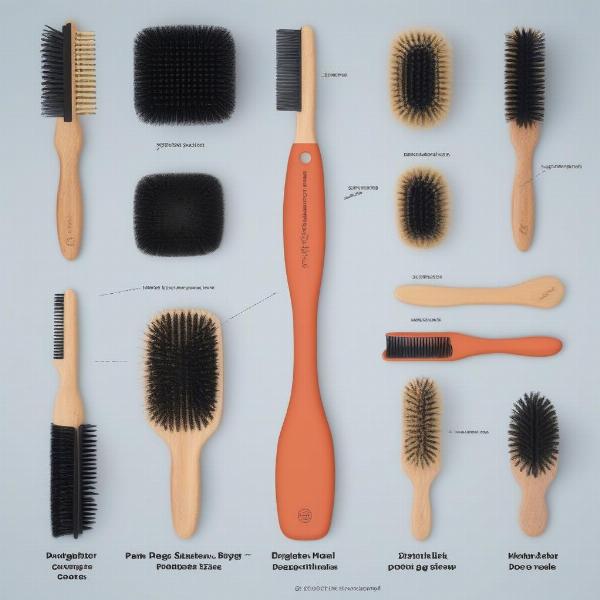A dog hair rubber brush can be a game-changer in your grooming routine. These versatile tools not only remove loose fur but also massage your dog’s skin, promoting a healthy coat and a happy pup. Whether you’re dealing with a shedding nightmare or simply want to keep your furry friend looking their best, a rubber brush is a valuable addition to your pet care arsenal. This guide will explore the benefits of using a dog hair rubber brush, how to choose the right one, and tips for effective grooming.
Choosing the Right Rubber Dog Hair Brush
 Lựa chọn bàn chải cao su cho chó
Lựa chọn bàn chải cao su cho chó
Not all rubber brushes are created equal. Consider these factors when choosing:
- Bristle Length and Density: Short, dense bristles are best for short-haired dogs, while longer, more spaced-out bristles are suitable for longer coats.
- Size and Shape: Choose a brush size that’s comfortable for you to hold and appropriate for your dog’s size. Oval, rectangular, and glove-shaped brushes are available.
- Handle Design: A comfortable, non-slip handle will make grooming easier and more enjoyable for both you and your dog.
Benefits of Using a Rubber Dog Hair Brush
- Effective Shedding Control: Rubber bristles attract loose hair like a magnet, minimizing shedding and keeping your home cleaner. This is especially beneficial for dogs that shed heavily.
- Gentle Massage: The soft rubber bristles stimulate blood circulation to the skin, promoting a healthy coat and a relaxing experience for your dog.
- Easy to Clean: Unlike traditional bristle brushes, rubber brushes are incredibly easy to clean. Simply rinse with water and the collected hair rinses away.
- Affordable: Dog hair rubber brushes are typically less expensive than other deshedding tools, making them a budget-friendly option.
- Versatile: Rubber brushes can be used wet or dry, making them ideal for bath time and everyday grooming. They can even be used to gently remove dirt and debris.
How to Use a Dog Hair Rubber Brush
- Start with a dry coat: For best results, brush your dog when their fur is dry.
- Brush in the direction of hair growth: Gentle, short strokes are most effective.
- Focus on areas prone to shedding: Pay extra attention to the back, belly, and tail.
- Clean the brush regularly: Rinse the brush with water after each use to remove collected hair.
What if my dog doesn’t like the rubber brush?
Sometimes, a dog might be hesitant about a new grooming tool. Try introducing the rubber dog hair brush slowly, pairing it with positive reinforcement like treats or praise. Start by gently touching the brush to their body and gradually increase the duration of brushing sessions as they become more comfortable.
“Introducing a new grooming tool should be a positive experience,” says Dr. Amelia Shepherd, a certified veterinary dermatologist. “Patience and positive reinforcement are key to helping your dog adjust.”
Rubber Brush vs. Deshedding Brush: Which is right for my dog?
While both are designed to remove loose hair, a deshedding brush for dogs is typically more aggressive and designed for dogs with thick undercoats. A dog hair comb is helpful for removing mats and tangles. A rubber brush is a gentler option, suitable for all coat types and particularly good for sensitive skin. For stubborn mats you could try a groomi comb for dogs.
“The best brush for your dog depends on their individual needs,” adds Dr. Shepherd. “Consider their coat type, shedding frequency, and skin sensitivity when making your decision.”
Conclusion
A dog hair rubber brush is a versatile and affordable tool that can significantly improve your dog’s grooming experience. From reducing shedding to promoting a healthy coat, the benefits are undeniable. By choosing the right brush and following proper grooming techniques, you can keep your furry friend looking and feeling their best.
FAQ
-
Can I use a rubber brush on a wet coat? While it’s best to use a rubber brush on dry fur for optimal shedding control, you can also use it on a wet coat during bath time to help distribute shampoo and conditioner.
-
How often should I use a rubber brush on my dog? This depends on your dog’s breed and shedding frequency. For heavy shedders, daily brushing is recommended. For other breeds, a few times a week may suffice.
-
Are rubber brushes suitable for all dog breeds? Yes, rubber brushes are generally safe and gentle enough for all dog breeds, including those with sensitive skin.
-
Can a rubber brush help with mats and tangles? While rubber brushes can help prevent mats and tangles, they may not be effective at removing existing ones. A comb is a better tool for that purpose.
-
How do I clean a rubber brush? Simply rinse the brush with warm water after each use. You can also use a mild soap if needed.
-
Are there different types of rubber brushes? Yes, there are various types of rubber brushes available, differing in size, shape, and bristle length. Choose one that is appropriate for your dog’s size and coat type.
-
Can I use a rubber brush on other pets? While designed for dogs, rubber brushes can also be used on other pets with fur, such as cats.
If you’re looking for tips on cleaning up after your dog, check out our article on how to remove dog hair from car.
About ILM Dog
ILM Dog is your one-stop resource for expert advice on dog care and wellbeing. We offer practical guidance on everything from breed selection and puppy care to senior dog health and training. Our mission is to empower dog owners worldwide with the knowledge and resources they need to provide their furry companions with the best possible care. From nutrition and grooming to behavior and health, we cover all aspects of dog ownership. Contact us at [email protected] or +44 20-3965-8624 for personalized advice.